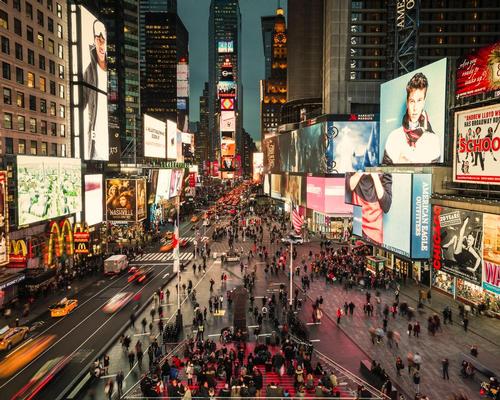19 Apr 2017
Snøhetta celebrate 'radical reinvention' of New York's Times Square
BY Kim Megson

International architecture studio Snøhetta are today (19 April) celebrating the official completion of their hotly-anticipated revamp of the most visited destination in the United States – New York’s Times Square.
The firm was commissioned in 2010 to find a way of doubling the amount of public space in the square by creating a new 2.5 acre pedestrian-only plaza on Broadway; transforming a congested vehicular district into a world-class civic space capable of catering to the site’s 45 million annual visitors.
At a press conference held in the city, Snøhetta, the NYC Department of Transportation, the Department of Design and Construction, and the Times Square Alliance stated that the reimagined ‘Crossroads of the World’ will now embrace its role as a “radically open civic square and stage for public life and freedom of expression.”
Snøhetta founding partner Craig Dykers said: “Conceived as a project whose success would be measured not only by its new aesthetic but also the long-term physical, psychological and economic benefits on its community, the reinvention of Times Square stands as a model for how the design of our urban landscapes can improve health and well-being of its users while providing an important stage for public gathering.”
To achieve this, the design called for the removal of decades of old infrastructure cluttering the heart of the Times Square Theater District, known as the ‘Bowtie’ – including a multi-legged diagonal intersection – and the creation of a unified ground plane from building front to building front.
Since cars were blocked from the site in 2009, and the first section of Snøhetta’s pedestrian street opened to the public in spring 2014, the transformation has already seen the amount of pedestrian injuries decrease by 40 per cent, vehicular accidents decrease by 15 per cent, overall crime in the area decrease by 20 per cent and pollution levels decrease by 60 per cent.
Ten 50ft-long granite benches – embedded with power and broadcast sources to facilitate 350 annual public events without the need for diesel generators – allow pedestrians to move through the area more comfortably, complementing the energy of the famous Times Square lights above.
In a statement, Snøhetta said the whole project reinforces the Bowtie’s role as an outdoor stage.
“A clear and simple ground surface made of pre-cast concrete pavers creates a strong anchor for the space, allowing the excitement of Times Square’s commercial components to shine more brightly above,” they said. “The area’s new two-toned custom pavers are embedded with nickel-sized steel discs that capture the neon glow from the signs above and playfully scatter it across the paving surface, referencing marquee lights and Times Square’s theatre history.
“However, rather than adding more visual distractions like signage, the design harnesses more implicit gestures such as the benches and renovated curbs brought up to street level, allowing users to feel psychologically at ease in an often over-stimulating public space.”
The studio added that understanding the magnitude of the crowds, which can number over 30,000 a day, and their and patterns of movement was “fundamental to creating a successful new life for one of the most iconic public spaces in the world.”
The landscape architect and urbanist James Corner – himself familiar with designing for New York’s crowds through his work on the High Line – also recently told CLAD how well-designed public spaces in big cities can improve our health and wellbeing, while acting as “platforms of democracy and tolerance.”
.@snohetta's vision for #TimesSquare was less about adding things & more about taking things away, bringing maturity and depth to the space. pic.twitter.com/YoXXVViY9Y
— Times Square (@TimesSquareNYC) April 19, 2017
Close Window